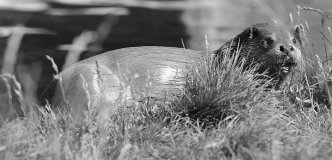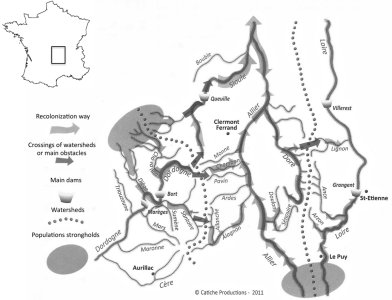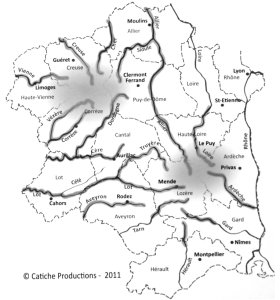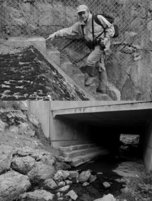IUCN/SSC Otter Specialist Group Bulletin

|
©IUCN/SCC Otter Specialist Group Citation: Bouchardy, C., Lemarchand, C., Boulade, Y., Gouilloux, N., Rosoux, R. and Berny, P. (2011) Natural Recolonization of the Eurasian Otter (Lutra lutra) in Massif Central (France). Proceedings of XIth International Otter Colloquium, IUCN Otter Spec. Group Bull. 28B: 26 - 29 Natural Recolonization of the Eurasian Otter (Lutra lutra) in Massif Central (France) Christian Bouchardy1, Charles Lemarchand1,2 , Yves Boulade1, Noël Gouilloux1, René Rosoux3 and Philippe Berny2
1Catiche Productions, 1 rue de Jardinot, 63830 Nohanent, France. Email: societe@catiche.fr
|
 Eurasian otter – Photo C. Lemarchand |
|
Abstract: The natural expansion of otter populations from thier stronghold in the Massif Central was followed over four decades, with regular monitoring. In this area, many of the watersheds between drainage basins are themselves wetlands, and otters were able to overcome many natural barriers such as dams, by crossing these watersheds. This, along with conservation of riparian corridors, has facilitated otter recovery. The connections between wetlands and watersheds is as important as the linear routes along watercourses. |
| Keywords: Eurasian otter; Massif Central; recolonisation; watersheds |
| Française | Español |
Once widespread in France as on the rest of the continent, the Eurasian otter (Lutra lutra) has significantly decreased over the whole of its range, due to direct persecution and habitat destruction. When the legal protection of otters was decided in France in 1972, the species had already disappeared from many parts of the country and its overall situation was catastrophic. At that time, however, the Massif Central (part of the Auvergne and Limousin regions, and departments of Lozere and Aveyron) was an exception, since it was the last stronghold of populations of France, with those located along the Atlantic coast (Bouchardy, 1986; Lemarchand and Bouchardy, 2011).
Local surveys launched in the mid-1980s (Bouchardy, 1986; Rosoux and Green, 2004) showed a very slow increase in population following legal protection, in the upper parts of some of the Loire and Dordogne Rivers tributaries catchments. These two rivers constituted the two last strongholds for the species in central France (Bouchardy, 1986) The absence of any reintroduction of the species let run a completely natural movement, and assessed the study or rehabilitation of biological corridors used by individuals during territories foraging. Regular monitoring of populations was performed on thousands of miles of riverbanks and highlighted the main obstacles to expanding populations, such as the presence of dams or inadequate road network (Bouchardy, 1986; Bouchardy et al., 2001; Rosoux and Green, 2004; Lemarchand and Bouchardy, 2011). Obstacles were identified by systematic analysis of local crossing by otters, according to the ability of the species and height of dams, local conformation of riverbanks under bridges or near dams (Chanin, 2003; Lemarchand and Bouchardy, 2011). Some of these barriers have been equipped by specific passages, as shown (Fig. 1).
The expansion of otter populations in the Massif Central, followed and studied for nearly 40 years, also underlined the ability of the species in crossing the basin sources: winter monitoring allowed snow tracking along rivers of different basins running from same wetlands (Bouchardy et al., 2001). In the departments concerned, many rivers originate in different valleys very close to each other, and some wetlands (marshes and bogs) feed different watersheds. Inter-basin hydrologic continuity, combined with the preservation of riparian corridors of many rivers of the Massif Central, facilitated the recovery of the otter, and has even allowed the otter to bypass dams by the watershed of tributaries.
Figure 2 shows the very special movement of natural recolonization, from the two population nuclei cited above (upper parts of Dordogne River and Loire River tributaries). It should be noted that the water system in this area is divided into three basins: the upper Dordogne to the west, that of the Allier in the middle, and that of the Loire to the east. The bold arrows indicate the crossing of lines of the watershed that allowed the otter to move from one basin to another.
 |
| Figure 2.
Recolonization of the otter in the north-western Massif Central in France. Drawing Noël Gouilloux - Catiche Productions Click for larger image |
There is, after reading this image, the stronghold located northwest extended in three directions from the early 1980s. The entire upper part of the Sioule River was occupied until the Queuille dam, which could be passed from 1992 following the construction of a passage for otters over the dam (Figure 1); the recolonization movement of otters along Chavanon River catchment, blocked by the Bort-les-Orgues dam, rose higher on the Dordogne River, where it crossed the line of watershed to fall on Couze Rivers (Pavin, Chambon, Monne) between 1985 and 1990, which in turn flow into the Allier River. Finally, further south, from early 1990 a connection was possible between the Santoire River, which belongs to Dordogne River basin, and streams of Allanche and Alagnon River, which in turn flows into the basin of the Allier Rivers. Snow tracking during winter monitoring underlined that wetlands that lie between the Santoire River and the Allanche River played a key role, allowing otters coming up in the wetlands in spring to hunt amphibians to move from one basin to another.
For the stronghold located in the South, the movement is simpler, since it runs upstream to downstream on both rivers. Along the Allier River, the otter population that colonized the river joined the end of the core northwest, which had arrived on the Allier River, via Alagnon, Couzes and Sioule Rivers between 2000 and 2005, as shown by annual monitoring. On the Loire River, however, the movement is stuck at Grangent dam, but evidence appears downstream, through a new lane watershed in wetlands between the tributaries of the Dore River and others of the Loire River since 2005, such as Lignon River.
In summary, this movement of colonization, followed step by step over four decades, shows that such a phenomenon is much more complex than one might imagine, and the connections of wetlands and basins heads play a role as important as the more traditional continuity from upstream to downstream.
It can be noted that this movement of natural recolonization, now extends to the whole of the Massif Central, along Vienne, Creuse, Cher, Allier, Loire, Ardèche, Gard, Hérault, Tarn, Aveyron, Lot, Dordogne Rivers catchments, and, as shown clockwise (Fig. 3).
 |
| Figure 3.
Recolonization of the otter in the Massif Central (France). Drawing Noël Gouilloux - Catiche Productions Click for larger image |
REFERENCES
Bouchardy, C. (1986). La loutre. Sang de la Terre, 186p.
Bouchardy, C., Boulade, Y., Rosoux, R., Gouilloux, N. (2001). La loutre d’Europe, histoire d’une sauvagarde. Catiche productions – Libris, 32p.
Chanin, P. (2003). Ecology of the European otter. Conserving Natura 2000 Rivers Ecology Series No 10. Peterborough, English Nature.
Lemarchand, C., Bouchardy, C. (2011). La loutre d’Europe, histoire d’une sauvegarde. Catiche Productions, 32p.
Rosoux, R. and Green, J. (2004). La Loutre. Belin Eveil Nature, 96p
Résumé :
Awaiting text
Revenez au dessus
Resumen:
Awaiting text
Vuelva a la tapa
